| Revision as of 15:15, 23 February 2013 editJhendin (talk | contribs)Extended confirmed users5,404 editsm language add onTag: Addition of interwiki link← Previous edit | Revision as of 16:06, 23 February 2013 edit undoDawnseeker2000 (talk | contribs)Autopatrolled, Extended confirmed users, File movers, New page reviewers, Pending changes reviewers, Rollbackers483,529 edits drop iwTag: Removal of all interwiki links; Wikidata is liveNext edit → | ||
| Line 821: | Line 821: | ||
| ] | ] | ||
| ] | ] | ||
| ] | |||
| ] | |||
| ] | |||
| ] | |||
| ] | |||
| ] | |||
| ] | |||
| ] | |||
| ] | |||
| ] | |||
| ] | |||
Revision as of 16:06, 23 February 2013
"Tallahassee" redirects here. For other uses, see Tallahassee (disambiguation). State Capital in Florida, United States| Tallahassee | |
|---|---|
| State Capital | |
| City of Tallahassee | |
 Downtown Tallahassee Downtown Tallahassee | |
 FlagOfficial seal of TallahasseeSeal FlagOfficial seal of TallahasseeSeal | |
| Nickname(s): "Tally", "The 850" | |
| Motto: Florida's Capital City | |
 Location in Leon County and the state of Florida Location in Leon County and the state of Florida | |
| Country | United States |
| State | Florida |
| County | Leon |
| Established | 1824 |
| Government | |
| • Type | Commission–Manager |
| • Mayor | John Marks |
| Area | |
| • State Capital | 103.5 sq mi (268 km) |
| • Land | 100.3 sq mi (260 km) |
| • Water | 3.2 sq mi (8 km) |
| Elevation | 203 ft (62 m) |
| Population | |
| • State Capital | 181,376 (128th) |
| • Density | 1,809.3/sq mi (698.6/km) |
| • Urban | 240,223 |
| • Metro | 367,413 |
| Time zone | UTC-5 (EST) |
| • Summer (DST) | UTC-4 (EDT) |
| ZIP code(s) | 32300–32399 |
| Area code | 850 |
| FIPS code | 12-70600Template:GR |
| GNIS feature ID | 0308416Template:GR |
| Website | www |
Tallahassee (/ˌtæləˈhæsi/) is the capital of the U.S. state of Florida. It is the county seat and only incorporated municipality in Leon County, and is the 128th largest city in the United States. Tallahassee became the capital of Florida, then the Florida Territory, in 1824. In 2010, the population recorded by the U.S. Census Bureau was 181,376, and the Tallahassee metropolitan area is 367,413.
Tallahassee is home to several colleges and universities, notably Florida State University and Florida A&M University. Others include Tallahassee Community College and branches of Saint Leo University, Thomas University, Keiser University, Barry University, Flagler College, and Embry-Riddle Aeronautical University.
Tallahassee is a center for trade and agriculture in the Florida Panhandle and is served by Tallahassee Regional Airport. With one of the fastest growing manufacturing and high tech economies in Florida, its major private employers include a General Dynamics Land Systems manufacturing facility (military and combat applications), the Municipal Code Corporation, which specializes in the publication of municipal and county legal references; and a number of national law firms, lobbying organizations, trade associations and professional associations, including the Florida Bar and the Florida Chamber of Commerce. It is recognized as a regional center for scientific research, and is home to the National High Magnetic Field Laboratory, the largest and highest-powered magnet research laboratory in the world.
History
Main article: History of Tallahassee, Florida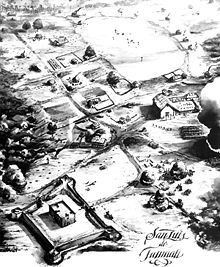

During the 17th century several Spanish missions were established in the territory of the Apalachee to procure food and labor for the colony at St. Augustine. The largest, Mission San Luis de Apalachee, has been partially reconstructed by the state of Florida. The name "Tallahassee" is a Muskogean Indian word often translated as "old fields", and it likely stems from the Creek (later called Seminole) Indians who migrated from Georgia and Alabama to this region in the late 18th and early 19th centuries. They found large areas of cleared land previously occupied by the Apalachee tribe. Earlier, the Mississippian Indians built mounds near Lake Jackson around AD 1200, which survive today in the Lake Jackson Archaeological State Park.
The expedition of Panfilo de Narvaez encountered the Apalachees, although it did not reach the site of Tallahassee. Hernando de Soto and his expedition occupied the Apalachee town of Anhaica in what is now Tallahassee in the winter of 1538–1539.

Based on archaeological excavations this site is now known to be located about 0.5 miles (800 m) east of the present Florida State Capitol. The DeSoto encampment is believed to be the first place Christmas was celebrated in the continental United States.
During the First Seminole War, General Andrew Jackson fought two separate skirmishes in and around Tallahassee. The first battle took place on November 12, 1817. Chief Neamathla, of the village of Fowltown, just west of present day Tallahassee had refused Jackson's orders to relocate. Jackson responded by entering the village, burning it to the ground, and driving off its occupants. The Indians later retaliated, by killing 50 soldiers and civilians. Jackson reentered Florida in March 1818. According to Jackson's adjutant, Colonel Robert Butler, they "advanced on the Indian village called Tallahasse (sic) two of the enemy were made prisoner."
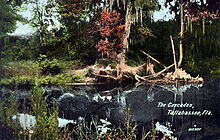
Tallahassee became the capital of Florida during the second legislative session. It was chosen as it was roughly equidistant from St. Augustine and Pensacola, which had been the capitals of the Spanish colonies of East Florida and West Florida. The first session of Florida's Legislative Council—as a territory of the United States—met on July 22, 1822 at Pensacola and members from St. Augustine traveled fifty-nine days by water to attend. The second session was in St. Augustine and required western delegates to travel perilously around the peninsula on a twenty-eight day trek. During this session, it was decided that future meetings should be held at a half-way point. Two appointed commissioners selected Tallahassee, at that point an abandoned Apalachee settlement, as a halfway point. In 1824 the third legislative session met there in a crude log capitol.
From 1821 through 1845 the rough-hewn frontier capital gradually grew into a town during Florida's territorial period. The Marquis de Lafayette, French hero of the American Revolution, returned for a tour of the United States in 1824. The US Congress voted to give him $200,000 (the same amount he had given the colonies in 1778), US citizenship, and the Lafayette Land Grant, 36 square miles (93 km) of land that today includes large portions of Tallahassee. In 1845 a Greek revival masonry structure was erected as the Capitol building in time for statehood. Now known as the "old Capitol," it stands in front of the Capitol high rise building that was built in the 1970s.
Tallahassee was the center of the slave trade in Florida as the city was the capital of the Cotton Belt. During the American Civil War, Tallahassee was the only Confederate state capital east of the Mississippi not captured by Union forces. A small engagement, the Battle of Natural Bridge, was fought south of the city on March 6, 1865.
During the 19th century the institutions that would eventually be combined into what is now known as Florida State University were established in Tallahassee, firmly cementing it as a university town. These including the Tallahassee Female Academy (founded 1843) and the Florida Institute (founded 1854). In 1851 the Florida legislature decreed two seminaries to be built on either side of the Suwanee River, East Florida Seminary and West Florida Seminary. In 1855 West Florida Seminary was transferred to the Florida Institute building (which had been established as an inducement for the state to place the seminary in Tallahassee). In 1858 the seminary absorbed the Tallahassee Female Academy and became coeducational.
After the Civil War much of Florida's industry moved to the south and east, a trend that continues today. The end of slavery hindered the cotton and tobacco trade, and the state's major industries shifted to citrus, lumber, naval stores, cattle ranching and tourism. The post-Civil War period was also when many former plantations in the Tallahassee area were purchased by wealthy northerners for use as winter hunting preserves. This included the hunting preserve of Henry L. Beadel, who bequeathed his land for the study of the effects of fire on wildlife habitat. Today the preserve is known as the Tall Timbers Research Station and Land Conservancy, nationally recognized for its research into fire ecology and the use of prescribed burning.

Until World War II Tallahassee remained a small southern town with virtually the entire population living within 1 mile (2 km) of the Capitol. The main economic drivers were the universities and state government, where politicians met to discuss spending money on grand public improvement projects to accommodate growth in places such as Miami and Tampa Bay, hundreds of miles away from the capital. By the 1960s there was a movement to transfer the capital to Orlando, closer to the growing population centers of the state. That motion was defeated and the 1970s saw a long-term commitment by the state to the capital city with construction of the new capitol complex and preservation of the old Florida State Capitol building.
In 1977 a 23-story high-rise Capitol building designed by architect Edward Durell Stone was completed, which is now the third-tallest state capitol building in the U.S. In 1978 the old capitol was scheduled for demolition, but the State Of Florida decided to keep the Old Capitol as a museum. The new and old capitols still stand to this day in Tallahassee.
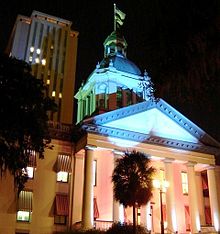
Tallahassee was the center of world attention for six weeks during the 2000 United States Presidential election recount, which involved numerous rulings by the Florida Secretary of State and the Florida Supreme Court.
Geography
Template:GR According to the United States Census Bureau the city has an area of 98.2 square miles (254.3 km), of which, 95.7 square miles (247.9 km) is land and 2.5 square miles (6.5 km) (2.59%) is water.


Tallahassee's terrain is hilly by Florida standards, being located at the southern end of the Red Hills Region, just above the Cody Scarp. The elevation varies from near sea level to just over 200 feet (61 m), with the state capitol on one of the highest hills in the city. The city includes two large lake basins, Lake Jackson and Lake Lafayette, and borders the northern end of the Apalachicola National Forest.
The flora and fauna are similar to those found in the mid-south and low country regions of South Carolina and North Carolina. The palm trees are the more cold-hardy varieties like the state tree, the Sabal Palmetto. Pines, magnolias, and a variety of oaks are the dominant trees. The Southern Live Oak is perhaps the most emblematic of the city.
Climate


Tallahassee has a humid subtropical climate (Köppen Cfa), with long summers and mild winters. Summers here are hotter than in the Florida peninsula and it is one of the few cities in the state to occasionally record temperatures above 100 °F (37.8 °C), averaging 2.4 days annually. The record high of 105 °F (41 °C) was set on June 15, 2011. Summer is characterized by brief intense showers and thunderstorms that form along the afternoon sea breeze from the Gulf of Mexico. The average high temperature in July (the hottest month of the year) is 92 °F (33 °C) with lows averaging around 72 °F (22 °C). The city is much cooler in the winter. During the Great Blizzard of 1899 the city reached −2 °F (−19 °C), the only recorded sub-zero Fahrenheit reading in Florida. The average high temperature in January (the year's coldest month) is around 65 °F (18 °C) while nighttime lows average 36 °F (2 °C).

Over the last 100 years the city has recorded several snowfalls; the heaviest was 2.8 inches (7.1 cm) on February 13, 1958. A White Christmas occurred in 1989, and in 1993 there were traces of snow and high winds. Historically, the city usually records at least flurries every three to four years, but on average, measurable amounts of snow 1.0 inch (2.5 cm) occur only every 17 years. The last measurable snowfall took place in December 1989. The natural snow line (regular yearly snowfalls) ends 200 miles (320 km) to the north at Macon, Georgia, but the city averages 32 nights where the temperature falls below freezing, and, on average, the first freeze occurs on November 20, the last on March 22.
Although several hurricanes have brushed Tallahassee with their outer rain and wind bands, in recent years only Hurricane Kate, in 1985, has struck Tallahassee directly. The Big Bend area of North Florida sees several tornadoes each year during the season, but none have hit Tallahassee in living memory. During extremely heavy rains, some low-lying parts of Tallahassee may flood, notably the Franklin Boulevard area adjacent to the downtown and the Killearn Lakes subdivision (which is not within the city limits proper) on the north side.
| Climate data for Tallahassee, Florida (Tallahassee Regional Airport), 1981–2010 normals, extremes 1892–present | |||||||||||||
|---|---|---|---|---|---|---|---|---|---|---|---|---|---|
| Month | Jan | Feb | Mar | Apr | May | Jun | Jul | Aug | Sep | Oct | Nov | Dec | Year |
| Record high °F (°C) | 83 (28) |
89 (32) |
91 (33) |
95 (35) |
102 (39) |
105 (41) |
104 (40) |
103 (39) |
102 (39) |
95 (35) |
88 (31) |
84 (29) |
105 (41) |
| Mean daily maximum °F (°C) | 64 (18) |
68 (20) |
74 (23) |
80 (27) |
87 (31) |
91 (33) |
92 (33) |
93 (34) |
89 (32) |
82 (28) |
73 (23) |
66 (19) |
80 (27) |
| Mean daily minimum °F (°C) | 39 (4) |
41 (5) |
47 (8) |
52 (11) |
62 (17) |
70 (21) |
72 (22) |
72 (22) |
68 (20) |
57 (14) |
48 (9) |
40 (4) |
55.8 (13.2) |
| Record low °F (°C) | 6 (−14) |
−2 (−19) |
20 (−7) |
29 (−2) |
34 (1) |
46 (8) |
57 (14) |
57 (14) |
40 (4) |
29 (−2) |
13 (−11) |
10 (−12) |
−2 (−19) |
| Average precipitation inches (mm) | 4.34 (110) |
4.84 (123) |
5.92 (150) |
3.06 (78) |
3.47 (88) |
7.73 (196) |
7.28 (185) |
7.34 (186) |
4.68 (119) |
3.23 (82) |
3.49 (89) |
3.90 (99) |
59.28 (1,505) |
| Average precipitation days (≥ 0.01 inch) | 8.9 | 8.4 | 7.9 | 6.1 | 7.1 | 13.6 | 15.9 | 14.4 | 8.5 | 5.7 | 6.6 | 8.1 | 111.2 |
| Source: NOAA | |||||||||||||
Nearby cities and suburbs

Demographics
Tallahassee is the twelfth fastest growing metropolitan area in Florida. Tallahassee’s 12.4 percent growth rate is higher than both Miami and Tampa and half that of Cape Coral-Fort Myers and Naples-Marco Island.
| Tallahassee Demographics | |||
|---|---|---|---|
| 2010 Census | Tallahassee | Leon County | Florida |
| Total population | 181,376 | 275,487 | 18,801,310 |
| Population, percent change, 2000 to 2010 | +20.4% | +15.0% | +17.6% |
| Population density | 1,809.3/sq mi | 413.1/sq mi | 350.6/sq mi |
| White or Caucasian (including White Hispanic) | 57.4% | 63.0% | 75.0% |
| (Non-Hispanic White or Caucasian) | 53.3% | 59.3% | 57.9% |
| Black or African-American | 35.0% | 30.3% | 16.0% |
| Hispanic or Latino (of any race) | 6.3% | 5.6% | 22.5% |
| Asian | 3.7% | 2.9% | 2.4% |
| Native American or Native Alaskan | 0.2% | 0.3% | 0.4% |
| Pacific Islander or Native Hawaiian | 0.1% | 0.1% | 0.1% |
| Two or more races (Multiracial) | 2.3% | 2.2% | 2.5% |
| Some Other Race | 1.3% | 1.5% | 3.6% |
| Census | Pop. | Note | %± |
|---|---|---|---|
| 1860 | 201 | — | |
| 1870 | 384 | 91.0% | |
| 1880 | 1,432 | 272.9% | |
| 1890 | 2,159 | 50.8% | |
| 1900 | 3,185 | 47.5% | |
| 1910 | 6,374 | 100.1% | |
| 1920 | 10,303 | 61.6% | |
| 1930 | 51,937 | 404.1% | |
| 1940 | 62,475 | 20.3% | |
| 1950 | 73,958 | 18.4% | |
| 1960 | 89,539 | 21.1% | |
| 1970 | 102,482 | 14.5% | |
| 1980 | 113,583 | 10.8% | |
| 1990 | 124,773 | 9.9% | |
| 2000 | 150,624 | 20.7% | |
| 2010 | 181,376 | 20.4% |
As of 2010, there were 84,248 households, of which 11.2% were vacant. As of 2000, 21.8% of which had children under 18 living in them. 30.1% were married couples living together, 13.2% had a female householder with no husband, and 53.4% were non-families. 34.7% of all households were made up of individuals and 6.0% had someone living alone who was 65 years of age or older. The average household size was 2.17 and the average family size was 2.86.
As of 2000, the city's population was spread out with 17.4% under the age of 18, 29.7% from 18 to 24, 27.9% from 25 to 44, 16.8% from 45 to 64, and 8.2% who were 65 years of age or older. The median age was 26 years. For every 100 females, there were 89.5 males. For every 100 females age 18 and over, there were 86.7 males.
In 2000, the median income for a household in the city was $30,571, and the median income for a family was $49,359. Males had a median income of $32,428 versus $27,838 for females. The per capita income for the city was $18,981. About 12.6% of families and 24.7% of the population were below the poverty line, including 21.6% of those under age 18 and 8.4% of those age 65 or over.
Educationally, the population of Leon County is the most highly educated population in Florida with 49.9% of the residents with either a Bachelor's, Master's, professional or doctorate degree. The Florida average is 22.4% and the national average is 24.4%.
Languages

As of 2000, 91.99% of residents spoke English as their first language, while 4.11% spoke Spanish, 0.63% spoke French, and 0.59% spoke German as their mother tongue. In total, 8.00% of the total population spoke languages other than English.
City accolades

- 1988: Money Magazine's Southeast's three top medium size cities in which to live.
- 1992: Awarded Tree City USA by National Arbor Day Foundation
- 1999: Awarded All-America City Award by the National Civic League
- 2003: Awarded Tree Line USA by the National Arbor Day Foundation.
- 2006: Awarded "Best In America" Parks and Recreation by the National Recreation and Park Association.
- 2007: Recognized by Kiplinger's Personal Finance Magazine as one of the "Top Ten College Towns for Grownups" (ranking second, behind Chapel Hill, North Carolina)
- 2007: Ranked second in the "medium sized city" class on Epodunk's list of college towns.
Government and politics
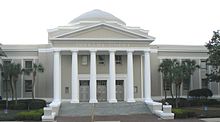
Tallahassee has traditionally been a Democratic city, and is one of the few cities in the South known for left-wing activism, along with Asheville and Austin. The city has voted Democratic throughout its history with a high voter-turnout. As of April 2007 there were 85,343 Democrats and 42,230 Republicans in Leon County. Other affiliations accounted for 22,284 voters.

Ion Sancho is the Supervisor of Elections for Leon County, Florida. Serving since January 1989, he has been reelected to five additional terms. One of only three (out of 67) supervisors of elections in Florida without party affiliation, under his administration Leon County's voter turnout percentage has consistently ranked among the highest of Florida's 67 counties, with a record setting 86% turnout in the November 2008 General Election.

Tallahassee took center stage during the Presidential Election of 2000, Bush v. Gore. On Election Day, before all polls closing in Florida, the major television networks estimated that then Vice President Al Gore had beaten Texas Gov. George W. Bush in Florida. These networks were later forced to retract the projection as votes were tabulated from Florida's heavily Republican western panhandle. As the night went on, it became clear that the victor in Florida would receive the electoral votes necessary to claim the presidency. The next morning, Vice President Gore heard that Mr. Bush was ahead by an estimated 50,000 votes and therefore called to concede the election. Not long after, hearing that thousands of votes in key Florida counties were not counted due to machine malfunctions and irregularities, Vice President Gore retracted his concession.
The election played itself out over the next 30 days with Tallahassee set as ground zero for the answer to who would become next president of the United States. About a dozen appeals were heard by the Florida Supreme Court arising from the disputed election, including two that resulted in oral arguments broadcast on live television. Ultimately, controversial Florida Secretary of State, Katherine Harris, certified the election for George W. Bush, winning Florida by a heavily disputed margin of 537 votes.

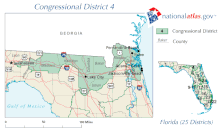
Consolidation
Voters of Leon County have gone to the polls four times to vote on consolidation of Tallahassee and Leon County governments into one jurisdiction combining police and other city services with already shared (consolidated) Tallahassee Fire Department and Leon County Emergency Medical Services. Tallahassee's city limits would increase from 103.1 square miles (267 km) to 702 square miles (1,820 km). Roughly 36 percent of Leon County's 265,714 residents live outside the Tallahassee city limits.
The proponents of consolidation have stated that the new jurisdiction would attract business by its size. Merging governments would cut government waste, duplication of services, etc. Professor Richard Feiock of the Department of Public Administration of Korea University and the Askew School of Public Administration and Policy of Florida State University states that no discernible relationship exists between consolidation and the local economy.
Each time, the measure was rejected: 1968: 10,381 (41.32%)|14,740 (58.68%); 1973: 11,056 (46.23%)| 12,859 (53.77%); 1976: 20,336 (45.01%) | 24,855 (54.99%); 1992: 37,062 (39.8%) | 56,070 (60.2%).
Federal representation and offices
Tallahassee is part of Florida's 2nd congressional district.
The United States Postal Service operates post offices in Tallahassee. The Tallahassee Main Post Office is located at 2800 South Adams Street. Other post offices in the city limits include Centerville Station, Leon Station, Park Avenue Station, and Westside Station.
The National Oceanographic and Atmospheric Administration maintains a National Weather Service in Tallahassee. Their coverage-warning area includes the eastern Florida Panhandle and adjacent Gulf of Mexico waters, the north-central Florida peninsula, and parts of southeast Alabama and southwestern Georgia.
Flag
The flag of Tallahassee, Florida is a white saltire on a blue field with the city coat of arms (the old capitol building) in the middle, very similar to the flag of Florida, of which Tallahassee is the capital.
Urban planning and expansion
The first plan for the Capitol Center was the 1947 Taylor Plan, which consolidated several government buildings in one downtown area. In 1974, the Capitol Center Planning Commission for the City of Tallahassee, Fla. responded to growth of its urban center with a conceptual plan for the expansion of its Capitol Center. Hisham Ashkouri, working for The Architects' Collaborative, led the urban planning and design effort. Estimating growth and related development for approximately the next 25 years, the program projected the need for 213,677 m² (2.3 million feet²) of new government facilities in the city core, with 3,500 dwelling units, 0.4 km² (100 acres) of new public open space, retail and private office space, and other ancillary spaces. Community participation was an integral part of the design review, welcoming Tallahassee residents to provide input as well as citizens’ groups and government agencies, resulting in the creation of six separate Design Alternatives. The best elements of these various designs were combined to develop the final conceptual design, which was then incorporated into the existing Capitol area and adjacent areas.

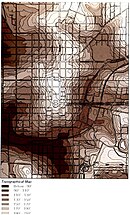
Tallest buildings
| Rank | Name | Street Address | Height feet | Height meters | Floors | Year |
|---|---|---|---|---|---|---|
| 1 | Florida State Capitol | 400 South Monroe Street, | 331 | 101 | 28 | 1977 |
| 2 | Turlington Building | 325 West Gaines Street, | 318 | 97 | 19 | 1990 |
| 3 | Plaza Tower | Adams St, | 276 | 84 | 24 | 2008 |
| 4 | Highpoint Center | 100 South Adams St | 239 | 70 | 15 | 1990 |
| 5 | Doubletree Hotel | 101 South Adams St, | 220 | 67 | 16 | 1972 |
Education


Primary and secondary education
Tallahassee anchors the Leon County School District. As of the 2009 school year Leon County Schools had an estimated 32,796 students, 2209 teachers and 2100 administrative and support personnel. The current superintendent of schools is Jackie Pons. Leon County public school enrollment continues to grow steadily (up approximately 1% per year since the 1990-91 school year). The dropout rate for grades 9-12 improved to 2.2% in the 2007–2008 school year, the third time in the past four years the dropout rate has been below 3%.
To gauge performance the State of Florida rates all public schools according to student achievement on the state-sponsored Florida Comprehensive Assessment Test (FCAT). Seventy-nine percent of Leon County Public Schools received an A or B grade in the 2008–2009 school year. The overall district grade assigned to the Leon County Schools is "A". Students in the Leon County School District continued to score favorably in comparison to Florida and national averages in the SAT and ACT student assessment tests. The Leon County School District has consistently scored at or above the average for districts statewide in total ACT and SAT mean composite scores.
List of middle schools
- Bellevue Middle School
- Cobb Middle School
- Deerlake Middle School
- Fairview Middle School
- Fort Braden School k-8
- Griffin Middle School
- Maclay School
- Montford Middle School
- Nims Middle School
- Raa Middle School
- Success Academy of Tallahassee
- Swift Creek Middle School
- Stars Middle School
List of high schools
- Amos P. Godby High School
- Atlantis Academy
- Community Christian School
- Florida A&M University Developmental Research School
- Florida State University High School
- James S. Rickards High School
- John Paul II Catholic High School
- Lawton Chiles High School
- Leon High School
- Lincoln High School
- Maclay School
- North Florida Christian High School
- SAIL High School
- Woodland Hall Academy
Higher education


The Florida State University (commonly referred to as Florida State or FSU) is a space-grant and sea-grant public university located in Tallahassee. It is a comprehensive doctoral research university with medical programs and significant research activity as determined by the Carnegie Foundation. The university consists of 15 separate colleges and 39 centers, facilities, labs and institutes that offer over 300 programs of study, including professional programs. FSU is a flagship university in the State University System of Florida. As one of Florida's primary graduate research universities, FSU awards over 2,000 graduate and professional degrees each year. In 2007, Florida State was placed in the first tier of research universities by the Florida Legislature, a distinction allowing FSU and the University of Florida to charge 40% higher tuition than other institutions in the State University System of Florida. While FSU was officially established in 1851 and is located on the oldest continuous site of higher education in Florida, at least one predecessor institution may be traced back to 1843, two years before Florida became a state.
Florida State University is also home to nationally ranked programs in many academic areas, including the sciences, social policy, film, engineering, library & information studies, the Arts, business, political science, social work, medicine, and law. Florida State is home to Florida's only National Laboratory—the National High Magnetic Field Laboratory and is the birthplace of the commercially-viable anti-cancer drug Taxol. The Florida State University athletics programs are favorites of passionate students, fans and alumni across the United States, especially when led by the Marching Chiefs of the FSU College of Music. Florida State is a member of the Atlantic Coast Conference and has won twelve national athletic championships as well as multiple individual competitor NCAA championship awards.
Founded on October 3, 1887, Florida A&M University (FAMU) is part of the State University System of Florida and is fully accredited by the Southern Association of Colleges and Schools. Distinguished by lush foliage and massive oaks, FAMU's main campus comprises 156 buildings spread over 422 acres (1.7 km) atop the highest of Tallahassee’s seven hills. The university also has several satellite campuses including a site in Orlando where the College of Law is located and sites in Miami, Jacksonville and Tampa for its pharmacy program. Florida A&M University offers 62 bachelor’s degrees and 39 master’s degrees. The university has 13 schools and colleges and one institute. FAMU has 11 doctoral programs which includes 10 Ph.D. programs: chemical engineering; civil engineering; electrical engineering; mechanical engineering; industrial engineering; biomedical engineering; physics; pharmaceutical sciences; educational leadership; and environmental sciences. Top undergraduate programs are architecture; journalism; computer information sciences and psychology. FAMU’s top graduate programs include pharmaceutical sciences along with public health; physical therapy; engineering; physics; master's of applied social sciences (especially history and public administration); business and sociology.
List of universities and colleges
- Barry University School of Adult and Continuing Education – Tallahassee Campus
- Embry-Riddle Aeronautical University
- Flagler College – Tallahassee Campus
- Florida A&M University
- Florida State University
- ITT Technical Institute
- Keiser University - Tallahassee
- Lewis M. Lively Area Vocational-Technical School
- Saint Leo University—Tallahassee Campus
- Tallahassee Community College
Public safety
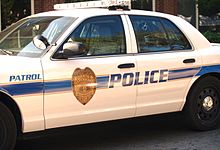
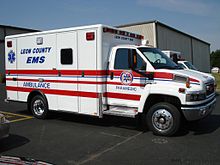
Established in 1841, the Tallahassee Police Department has the distinction of being the oldest police department in the Southern United States, and the third in the U.S., preceded only by the Philadelphia Police Department (established in 1758) and the Boston Police Department (established in 1838). Larger East Coast cities followed with New York City and Baltimore in 1845.
Law enforcement services are provided by the Tallahassee Police Department, the Leon County Sheriff's Office, the Florida Department of Law Enforcement, Florida Capitol Police, Florida State University Police Department, Florida A&M University Department of Public Safety, the Tallahassee Community College Police Department, and the Florida Highway Patrol.
The Tallahassee Growth Management Building Inspection Division is responsible for issuing permits and performing inspections of public and private buildings in the City limits. These duties include the enforcement of the Florida Building Codes and the Florida Fire Protection Codes. These standards are present to protect life and property. The Tallahassee Building Department is one of 13 currently Accredited Building Departments in the United States.
The Federal Bureau of Investigation, United States Marshals Service, Immigration and Customs Enforcement, Bureau of Alcohol, Tobacco, Firearms and Explosives, Secret Service and Drug Enforcement Administration have offices in Tallahassee. The US Attorney's Office for North Florida is based in Tallahassee.
Fire and rescue services are provided by the Tallahassee Fire Department and Leon County Emergency Medical Services.
Hospitals in the area include Tallahassee Memorial Healthcare, Capital Regional Medical Center and HealthSouth Rehabilitation Hospital of Tallahassee.
Places of interest
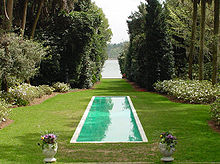


- Alfred B. Maclay Gardens State Park
- Challenger Learning Center
- Doak Campbell Stadium
- Elinor Klapp-Phipps Park
- Florida Governor's Mansion
- Florida State Capitol
- Florida Supreme Court
- Foster Tanner Fine Arts Gallery at Florida A&M University
- Fred George Basin Greenway
- Goodwood Museum and Gardens
- John G. Riley Center/Museum of African American History & Culture (Riley Museum)
- Knott House Museum
- Lake Ella
- Lake Henrietta
- Lake Jackson
- Lake Jackson Mounds Archaeological State Park
- Lake Lafayette
- Lafayette Heritage Trail Park
- Lake Munson
- LeMoyne Center for the Visual Arts
- Mary Brogan Museum of Art and Science (MOAS)
- Mission San Luis de Apalachee
- Museum of Fine Arts at Florida State University
- Museum of Florida History
- Myers Park
- National High Magnetic Field Laboratory
- North Florida Fairgrounds
- Railroad Square
- St. Clement's Chapel
- Southeastern Regional Black Archives Research Center and Museum
- Tallahassee Automobile Museum
- Tallahassee Little Theatre
- Tallahassee Museum
- Tom Brown Park
- James D. Westcott Building and Ruby Diamond Auditorium at Florida State University
- Young Actors Theatre
Located nearby are:
- Monticello Opera House in Monticello, Florida
- Natural Bridge Battlefield State Historic Site near Woodville
- Wakulla Springs State Park in Wakulla
- Lake Talquin in Quincy
- Leaf Theater in Quincy
Festivals and events

- Downtown Getdown (Seasonal)
- First Friday festivals at Railroad Square
- Greek Food Festival
- Red Hills Horse Trials
- Seven Days of Opening Nights
- Southern Shakespeare Festival
- Springtime Tallahassee
- Tallahassee Film Festival
- Tallahassee Marathon and Half Marathon
- Tallahassee Wine and Food Festival
- Winter Festival
Sports

- The Florida State University Seminoles compete in the NCAA Division I, and the Football Bowl Subdivision. The Florida State Football team won national championships in 1993 and 1999, and is the first school to go wire-to-wire (ranked #1 in every week of the season) in the history of college football. Florida State accomplished this unprecedented feat in 1999.
- The Florida A&M University Rattlers compete in the NCAA Division I, and the Football Championship Subdivision. Florida A&M won the first FCS national championship (then known as Division I-AA) in 1978.
- The Tallahassee Community College Eagles compete in the Panhandle Conference in Men's and Women's basketball, baseball and softball. The TCC men are two-time NJCAA region champions, including national runners-up in 2008.
- The Tallahassee RollerGirls are a women's flat track Roller Derby league that competes against other WFTDA and regional Roller Derby leagues.
- The Tallahassee Rugby Football Club are a Division III Rugby Club that competes in the Deep South Rugby Football Union.
- Local public high schools and middle schools compete in athletics, and share Gene Cox Stadium for football.
- The Tallahassee Scorpions were an EISL team that played from 1997 to 1998.
- The Tallahassee Tiger Sharks were an ECHL team from 1994 to 2001 that reached the ECHL semifinals on two separate occasions, in the 1994-95 and 1995-96 seasons.
- The Tallahassee Thunder were a charter member of the af2 arena football league that played in Tallahassee from 2000 to 2002.
- The Tallahassee Tigers were an American Basketball Association team.
- The Tallahassee Titans were an Indoor Football team that played their only season in the American Indoor Football Association.
- The Tallahassee-Leon County Civic Center, home of Florida State Seminoles basketball, hosted the First and Second Rounds of the 1995 NCAA Men's Division I Basketball Tournament, including a memorable game that saw 14-seed Weber State upset 3-seed Michigan State.
Transportation


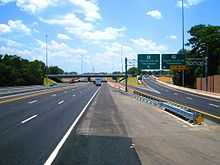
Aviation
- Tallahassee Commercial Airport (K68J)
- Tallahassee Regional Airport (KTLH)
Tallahassee Regional Airport is currently under construction, with airport, and city council, considering an ICE (International Customs Enforcement) center, for an International status.
Defunct airports
- Dale Mabry Field (closed 1961)
Mass transit
Railroads
- CSX operates a main freight line through the city.
- Amtrak's Sunset Limited historically served the city, but has been suspended since Hurricane Katrina struck in August 2005.
Defunct railroads
- Tallahassee Railroad, now a state trail.
- Carrabelle, Tallahassee and Georgia Railroad.
- See also History of Tallahassee, Florida
Major highways
 Interstate 10
Interstate 10 U.S. Route 27
U.S. Route 27 U.S. Route 90
U.S. Route 90 U.S. Route 319
U.S. Route 319 State Road 20
State Road 20 State Road 61
State Road 61 State Road 363
State Road 363- Capital Circle Beltway
- Apalachee Parkway
Economy
Companies based in Tallahassee include Citizens Property Insurance Corporation and the Municipal Code Corporation.
Top employers
According to Tallahassee's 2011 Comprehensive Annual Financial Report, the top employers in the area are:
| # | Employer | # of Employees |
|---|---|---|
| 1 | State of Florida | 20,355 |
| 2 | Florida State University | 13,856 |
| 3 | Leon County Schools | 4,370 |
| 4 | Tallahassee Memorial HealthCare | 3,130 |
| 5 | City of Tallahassee | 2,841 |
| 6 | Publix | 2,084 |
| 7 | Tallahassee Community College | 1,953 |
| 8 | Florida A&M University | 1,888 |
| 9 | Leon County | 1,778 |
| 10 | Capital Regional Medical Center | 1,188 |
Media
Newspaper
- Tallahassee Democrat daily newspaper
- FSView covering FSU
- The Famuan covering FAMU
Television
- WCTV (CBS) channel 6.1/ (My Network TV/This TV) channel 6.2
- WFSU (PBS) channel 11
- WTLH (Fox) channel 49
- WTWC (NBC) channel 40
- WTXL (ABC) channel 27
Radio
- WAIB-FM (Country)
- WBZE-FM (Hot Adult Contemporary)
- WFLA-FM (News/Talk)
- WFSQ-FM (Classical Music)
- WFSU-FM (News/Talk)
- WVFS-FM (College/Alternative)
- WGLF-FM (Classic Rock)
- WVFT (News/Talk)
- WHTF-FM (Top 40)
- WNLS-AM (Sports)
- WTNT-FM (Country)
- WXSR-FM (Rock)
Notable Tallahassee groups and organizations
- Cold Water Army—music group
- Creed—rock band
- Cream Abdul Babar—music group
- The Crüxshadows—music group
- Dead Prez—Alternative hip hop duo
- Go Radio—music group
- FAMU Marching 100—marching band
- FSU Marching Chiefs—marching band
- Look Mexico—rock band
- Mayday Parade—music group
- Mira—music group
- No Address—music group
- Socialburn—rock band
- Springtime Tallahassee—community festival group
- Tallahassee Symphony Orchestra—symphony orchestra
- Woman's Club of Tallahassee
Namesakes
- CSS Tallahassee—1864 Confederate cruiser
- USS Tallahassee (BM-9)—1908 United States Navy monitor, originally named USS Florida
- USS Tallahassee (CL-61)—1941 United States Navy light cruiser, converted to the aircraft carrier USS Princeton
- USS Tallahassee (CL-116)—1944 United States Navy light cruiser
- Tallahassee—Main Character in the movie Zombieland
- Tallahassee—LP recorded by The Mountain Goats and released on 4AD.
- Tallahassee Community School, Eastern Passage, Nova Scotia—named after CSS Tallahassee
- Tallahassee Tight—early 20th century blues singer
- T-Pain—Originally "Tallahassee Pain"
Sister cities
See also: List of sister cities in FloridaTallahassee has five sister cities, and two from Indonesia :
 Krasnodar, Russia
Krasnodar, Russia Konongo-Odumase, Ghana
Konongo-Odumase, Ghana St. Maarten, Netherlands Antilles
St. Maarten, Netherlands Antilles Sligo, Co. Sligo, Ireland
Sligo, Co. Sligo, Ireland Zamboanga City, Philippines (Planned)
Zamboanga City, Philippines (Planned) Ramat HaSharon, Israel
Ramat HaSharon, Israel Banjarbaru, Indonesia
Banjarbaru, Indonesia Semarang, Indonesia
Semarang, Indonesia Rugao, China
Rugao, China
Tallahassee views

-
 Turlington Education Building as seen from Civic Center.
Turlington Education Building as seen from Civic Center.
-
Downtown Tallahassee Doubletree Hotel.
-
Tennyson Condominiums as seen through a break in the downtown Federal Courthouse Square.
-
Georgia Belle Apartment Building in Downtown Tallahassee.
-
Highpoint Center as seen from the Florida Capitol.
-
Historic Tallahassee Exchange Building, the City's First "Highrise" Building.
-
Tallahassee War Memorial Monument Downtown.
-
Lewis State Bank, Florida's Oldest Surviving Bank Building.
-
Leon County Courthouse Building.
-
Tallahassee City Hall Building.
-
Historic Florida State House.
-
Kleman Plaza in the heart of downtown Tallahassee.
-
U.S. Federal Courthouse in Tallahassee.
-
Florida Korean War Memorial
-
Florida Supreme Court Building
-
Historic Midtown Tallahassee Church
-
 Old Downtown Tallahassee Clock
Old Downtown Tallahassee Clock
-
Tallahassee-Leon County Visitors Center
See also
- Consolidation of Leon County with Tallahassee
- Flag of Tallahassee, Florida
- Frenchtown (Tallahassee)
- History of Tallahassee, Florida
- Park Avenue Historic District (Tallahassee, Florida)
- Tallahassee Historic District Zones I And II
- Tallahassee in popular culture
References
- U.S. Census Bureau Population Estimates, Annual Estimates of the Resident Population for Incorporated Places over 100,000, Ranked by July 1, 2008 Population : April 1, 2000 to July 1, 2008
- "Table 1: 2010 Munnicipality Population" (CSV). 2010 Population. United States Census Bureau, Population Division. 2010-03-24. Retrieved 2009-07-01.
- Tallahassee, FL MSA Population. Retrieved on June 22, 2010
- BIG BEND: Rounding out the Economy
- Florida Chamber of Commerce | Home Page
- tallahasseenewsroom.com
- Hare, p.22
- Florida: A Short History, Michael V. Gannon, ISBN 0-8130-1167-1, Copyright @ 1993 by the Board of Regents of the State of Florida
- MOSQUITO COUNTY 1842 (Archived Page)
- Slavery and Plantation Growth in Antebellum, Florida, 1821–1860
- "History". Office of University Communications, Florida State University. Retrieved 21 December 2010.
- Florida Historic Capitol Museum
- ^ "NowData — NOAA Online Weather Data". National Oceanic and Atmospheric Administration. Retrieved 2012-02-25.
- "NOAA Weather Records Tallahassee". NOAA. Retrieved 15 June 2011.
- FLORIDA HISTORIC COLD WEATHER ARCHIVE retrieved 14 November 2012.
- Modern Language Association Data Center Results of Tallahassee, FL
- ePodunk College Towns Index
- Leon Supervisor of Elections Office
- City County Consolidation Efforts: Selective Incentives and Institutional Choice
- "Post Office Location - TALLAHASSEE." United States Postal Service. Retrieved on May 6, 2009.
- "Post Office Location - CENTERVILLE STATION." United States Postal Service. Retrieved on May 6, 2009.
- "Post Office Location - LEON STATION." United States Postal Service. Retrieved on May 6, 2009.
- "Post Office Location - PARK AVENUE STATION." United States Postal Service. Retrieved on May 6, 2009.
- "Post Office Location - WESTSIDE STATION." United States Postal Service. Retrieved on May 6, 2009.
- Purcell, John M. (2004). American City Flags (Part I: United States): 150 Flags from Akron to Yonkers. Trenton, NJ: North American Vexillological Association. p. 345. ISBN 978-0-9747728-0-6. Retrieved 2011-02-11.
- "Building Department Accreditation". IAS. Retrieved 24 May 2011.
- http://docs.google.com/viewer?a=v&q=cache:h1Av3-UtUsUJ:www.migrationinformation.org/pdf/OI-office-map.pdf+%22immigration+and+customs+enforcement%22+%22ra+offices%22&hl=en&gl=us&sig=AHIEtbS8enwgX1w57gq3OZexKkxUIp95vw
- City of Tallahassee CAFR
- "Tallahassee Democrat | Tallahassee news, community, entertainment, yellow pages and classifieds. Serving Tallahassee, Florida". tallahassee.com. 2012-10-12. Retrieved 2012-10-16.
- "Florida State University news from the FSView and Florida Flambeau including FSU sports, arts and life, opinion and classifieds. | fsunews.com". FSView. 2012-10-12. Retrieved 2012-10-16.
- "The Famuan - The Student Voice of Florida A&M University". Thefamuanonline.com. Retrieved 2012-10-16.
Further reading
- Hare, Julianne. Tallahassee: a capital city history. Arcadia Publishing. 2002
- Tebeau, Charlton, W. A History of Florida. University of Miami Press. Coral Gables. 1971
- Williams, John Lee. Journal of an Expedition to the Interior of West Florida October–November 1823. Manuscript on file at the State Library of Florida, Florida Collection. Tallahassee.
External links
- Talgov.com (Official website)
- The Local Conservation District - Information on Natural Resources, and Panoramic Tours
- The Tallahassee Democrat Newspaper
- Mission San Luis
- Tallahassee Trust for Historic Preservation - Places to Discover
- Ochlockonee River - St. Marks River Watersheds - Florida DEP
